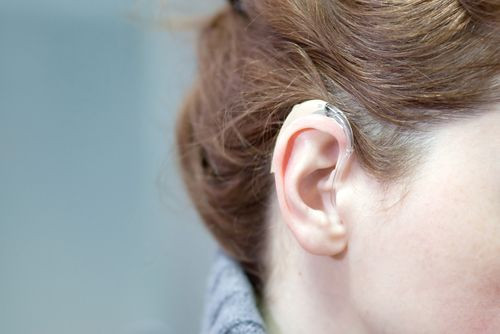Can You Hear Me Now? Hearing Loss And Its Role In Our Health And Happiness

Hearing loss can cause isolation, depression, and saddening frustrations as those who age, are born with, or have damaged their hearing on the job or at a rock concert. Your job and education can suffer, and experts believe hearing loss needs to become prioritized as an important health concern in order to improve the future hearing of others.
“I think hearing is an important part of our well-being and losing your hearing shouldn’t be something people just accept as a natural result of aging,” Dr. Stefanie Wolf, a clinical audiologist at Audiology of Nassau County, told Medical Daily. “I’m fulfilled by my job because it’s like turning a light on for some people and changing their lives. I help people by re-arming them with the tools they need to communicate.”
Most of Wolf’s patients are 65 years and older, which is no surprise considering by the time a person hits that age, one in three people have hearing loss. However, she also treats people with congenital hearing loss, which means the person is born without hearing, while gradual hearing loss seen in elderly patients happens over time. Wolf said they’re seeing younger and younger people noticing a change in their hearing and coming in for an exam, and believes it’s a combination of awareness and increased hearing damage from technology, such as earbud headphones.
Volume is measured in decibels, and as it rises, the volume increases along with its threat to your hearing. The volume of a normal conversation at a distance 3 feet away from the speaker is 60 dB, while a garbage truck, motorcycle, snowmobile, power lawnmower, snowmobile, or jackhammer can range from 85 to 100 dB. The upper threshold for human hearing is 130 dB and will tip you off because it’s when the noise becomes painful.
Danger of causing permanent damage to your hearing is when you expose yourself to a rock concert, jet engine firecracker, gunfire, ambulance siren, chainsaw, or the maximum volume of home stereo speakers. These all range between 110 to 140 dB and just one minute of exposure to any of these noises can result in permanent hearing loss, according to the National Institutes of Health. Gunfire and explosions are the number one cause of disability for those in combat at war.
Many parents question how ear buds are affecting their children’s hearing, especially when they can hear the music through the earphones themselves, indicating the high volume could be at damaging levels. Wolf suggests avoiding the background noise battle. If you’ve ever taken a subway ride, you’ll recognize right away how difficult it is to block out the outside noise with your own music unless you compete and crank up the output.
Expensive headphones have special noise-cancelling technology to both protect your ears from the high music volume and keep out disrupting background noise. “It’s all about the output levels,” Wolf said. She adds, you don’t have to spend a lot of money on ear protection, but by paying attention to the output level of headphones, ear buds, stereos, and loud noise proximity, your hearing can be greatly saved. The key is valuing what so many of us take for granted every day, like when a noisy car passes by, listening to a baby laugh, or participating in meetings at work.
“As untreated hearing loss progresses, your job performance decreases and there’s a known compensation decrease that comes with it,” Wolf said. “A big problem is they don’t want to appear stupid and they’ll just nod their head. It’s sad to think of all the things they’re missing throughout the day by faking it.”
Approximately 20 percent of adults in the United States have hearing loss, and an additional 48 percent report experiencing some degree of hearing loss, according to the American Speech-Language-Hearing Association. It causes isolation when a person can't hear what's going on around them and oftentimes it causes depression because of the gradual decrease in person-to-person interaction. Technology is changing and improving rapidly, but Wolf said working with patients and fitting them for hearing aids is meant to be a process and not just a product. Every day there are new hearing aids advertised, and it’s difficult to discern which ones are right for them, and sometimes the wealth of information confuses patients and deters them from seeking treatment.
Children And Hearing Loss
“We have to education people with information but not too much or it will overwhelm them, said Dr. Lori Trentacoste, an audiologist and owner of Island Better Hearing Inc., who performs hearing tests on kids, works as a consultant at schools and manages and teaches equipment use for inside the classroom. “A vast majority of people have emotional and professional ramifications from untreated hearing loss. In children, untreated hearing loss will cause brains to develop less, their education will suffer, and parents and teachers might think they have selective hearing.”
Two to three children out of every 1,000 are hard of hearing or deaf. However, Trentacoste has already seen an improvement in technology. Children used to be separated into special schools or misdiagnosed with attention deficit disorder (ADHD). Now there are better early intervention systems in place, such as children being checked at infancy for congenital hearing loss, and mainstreaming techniques to better acclimate a student into their classroom with others.
“I think we need to get doctors on board and insurance companies should be asking a few key questions. Most patients don’t know hearing tests are covered and their decision to get one often comes down to cost,” Trentacoste, who has grown up watching her father’s patients experience hearing loss and then taking over the business herself, said she’s seen changes but there’s still a long way to go. “Hearing loss shouldn’t be something that stops you when you age or hold a child back from learning.”



























